Bio-Based Acetic Acid Market
Bio-Based Acetic Acid Market Size and Share Forecast Outlook 2025 to 2035
Bio-based acetic acid market is projected to grow from USD 1.4 billion in 2025 to USD 3.8 billion by 2035, at a CAGR of 10.5%. Biomass Fermentation will dominate with a 61.0% market share, while food & beverage will lead the application segment with a 42.0% share.
Bio-Based Acetic Acid Market Forecast and Outlook 2025 to 2035
The global bio-based acetic acid market is valued at USD 1.4 billion in 2025. It is slated to reach USD 3.8 billion by 2035, recording an absolute increase of USD 2.4 billion over the forecast period. This translates into a total growth of 171.4%, with the market forecast to expand at a compound annual growth rate (CAGR) of 10.5% between 2025 and 2035.
The overall market size is expected to grow by nearly 2.71X during the same period, supported by increasing demand for sustainable chemicals, growing adoption of bio-based production technologies, and rising emphasis on renewable feedstock utilization across diverse industrial, food processing, and chemical manufacturing applications.
Quick Stats for Bio-Based Acetic Acid Market
- Bio-Based Acetic Acid Market Value (2025): USD 1.4 billion
- Bio-Based Acetic Acid Market Forecast Value (2035): USD 3.8 billion
- Bio-Based Acetic Acid Market Forecast CAGR: 10.5%
- Leading Source in Bio-Based Acetic Acid Market: Biomass Fermentation
- Key Growth Regions in Bio-Based Acetic Acid Market: North America, Europe, and East Asia
- Key Players in Bio-Based Acetic Acid Market: LanzaTech, Wacker Chemie, Godavari Biorefineries, Afyren, Zea2, Novozymes
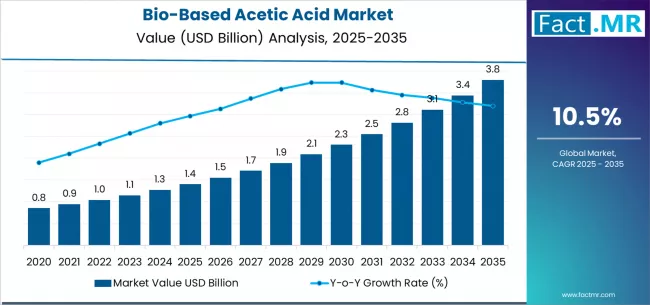
Between 2025 and 2030, the bio-based acetic acid market is projected to expand from USD 1.4 billion to USD 2.3 billion, resulting in a value increase of USD 0.9 billion, which represents 37.5% of the total forecast growth for the decade.
This phase of development will be shaped by increasing regulatory support for sustainable chemicals and circular economy initiatives, rising adoption of advanced fermentation technologies, and growing demand for renewable chemical feedstocks in pharmaceutical and food processing applications.
Chemical manufacturers and biotechnology companies are expanding their bio-based acetic acid capabilities to address the growing demand for sustainable and environmentally friendly chemical solutions that ensure product excellence and regulatory compliance.
Bio-Based Acetic Acid Market Key Takeaways
| Metric | Value |
|---|---|
| Estimated Value in (2025E) | USD 1.4 billion |
| Forecast Value in (2035F) | USD 3.8 billion |
| Forecast CAGR (2025 to 2035) | 10.5% |
From 2030 to 2035, the market is forecast to grow from USD 2.3 billion to USD 3.8 billion, adding another USD 1.5 billion, which constitutes 62.5% of the overall ten-year expansion. This period is expected to be characterized by the expansion of industrial biotechnology and advanced fermentation processes, the development of circular economy initiatives and waste-to-chemical technologies, and the growth of specialized applications in pharmaceutical manufacturing and sustainable packaging solutions.
The growing adoption of green chemistry principles and renewable material strategies will drive demand for bio-based acetic acid with enhanced purity and environmental performance features.
Between 2020 and 2025, the bio-based acetic acid market experienced remarkable growth from USD 0.6 billion to USD 1.4 billion, driven by increasing sustainability regulations and growing recognition of bio-based acetic acid as essential materials for enhancing environmental performance and reducing carbon footprint in diverse industrial and consumer applications.
The market developed as chemical engineers and biotechnology scientists recognized the potential for bio-based acetic acid technology to enhance sustainability credentials, improve product quality, and support regulatory compliance while meeting stringent performance requirements.
Technological advancement in fermentation processes and feedstock optimization began emphasizing the critical importance of maintaining consistent quality and cost-effectiveness in challenging market environments.
Why is the Bio-Based Acetic Acid Market Growing?
Market expansion is being supported by the increasing global demand for sustainable chemicals driven by environmental regulations and corporate sustainability commitments, alongside the corresponding need for renewable chemical feedstocks that can reduce carbon footprint, enable green chemistry processes, and maintain operational efficiency across various food processing, pharmaceutical, chemical manufacturing, and industrial applications.
Modern chemical manufacturers and food processors are increasingly focused on implementing bio-based acetic acid solutions that can improve environmental performance, enhance sustainability credentials, and provide consistent quality in demanding operating conditions.
The growing emphasis on circular economy principles and carbon neutrality targets is driving demand for bio-based acetic acid that can support renewable chemical production, enable waste-to-chemical processes, and ensure comprehensive environmental performance. Industrial manufacturers' preference for sustainable chemicals that combine environmental excellence with performance reliability and cost competitiveness is creating opportunities for innovative bio-based acetic acid implementations.
The rising influence of ESG investing and sustainable supply chain requirements is also contributing to increased adoption of bio-based acetic acid that can provide superior environmental characteristics without compromising functionality or economic viability.
Segmental Analysis
The market is segmented by source, application, and end use. By source, the market is divided into biomass fermentation, synthetic biology, and others. Based on application, the market is categorized into food & beverage, chemicals, and others. By end use, the market is split between industrial and consumer applications.
By Source, the Biomass Fermentation Segment Leads the Market
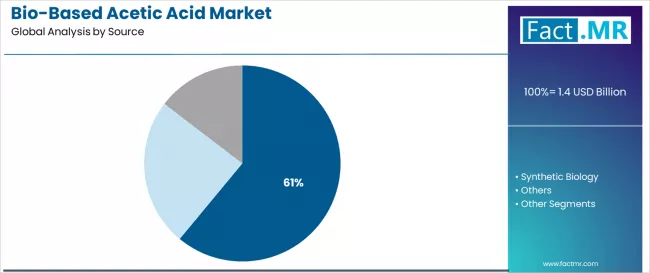
The biomass fermentation segment is projected to maintain its leading position in the bio-based acetic acid market in 2025 with a 61.0% market share, reaffirming its role as the preferred production method for sustainable acetic acid manufacturing applications.
Chemical manufacturers and biotechnology companies increasingly utilize biomass fermentation for its superior feedstock flexibility, excellent conversion efficiency, and proven effectiveness in reducing carbon footprint while maintaining product quality and cost competitiveness.
Biomass fermentation technology's proven effectiveness and production scalability directly address the industry requirements for sustainable chemical production and renewable feedstock utilization across diverse industrial platforms and application categories.
This source segment forms the foundation of modern bio-based chemical manufacturing, as it represents the technology with the greatest contribution to carbon footprint reduction and established performance record across multiple industrial applications and production scales. Chemical industry investments in sustainable production technologies continue to strengthen adoption among manufacturers and biotechnology companies.
With regulatory pressures requiring reduced emissions and improved sustainability performance, biomass fermentation aligns with both environmental objectives and economic requirements, making it the central component of comprehensive sustainable chemical strategies.
By Application, the Food & Beverage Segment Dominates Market Demand
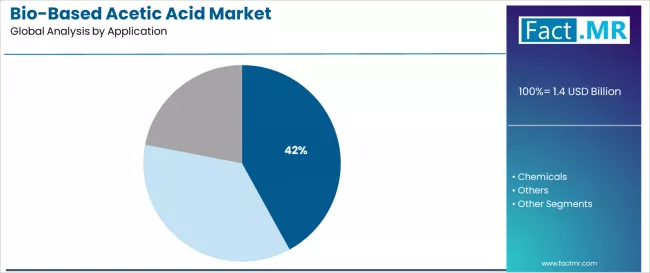
The food & beverage application segment is projected to represent the largest share of bio-based acetic acid demand in 2025 with a 42.0% market share, underscoring its critical role as the primary driver for bio-based acetic acid adoption across food preservation, beverage production, and food processing applications.
Food manufacturers prefer bio-based acetic acid for processing due to its exceptional purity characteristics, sustainability benefits, and ability to maintain food safety standards while supporting environmental objectives and regulatory compliance. Positioned as essential materials for modern food processing, bio-based acetic acid offers both performance advantages and sustainability benefits.
The segment is supported by continuous innovation in food technology and the growing availability of certified bio-based grades that enable superior food processing performance with enhanced safety and reduced environmental impact.
Additionally, food manufacturers are investing in comprehensive sustainability programs to support increasingly stringent environmental regulations and consumer demand for sustainable food products.
As food safety standards advance and sustainability requirements increase, the food & beverage application will continue to dominate the market while supporting advanced bio-based chemical utilization and processing optimization strategies.
By End Use, the Industrial Segment Commands Market Leadership
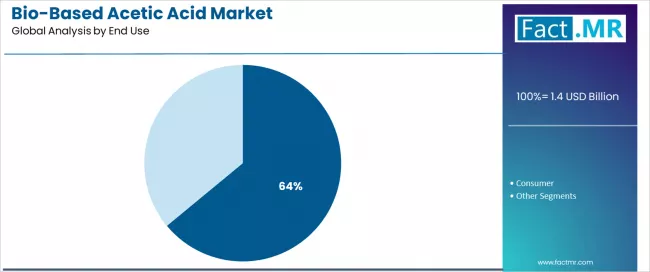
The industrial end use segment is projected to maintain the largest share of bio-based acetic acid consumption in 2025 with a 64.0% market share, highlighting its fundamental role in chemical manufacturing, pharmaceutical production, and industrial processing applications.
Industrial manufacturers prefer bio-based acetic acid for its comprehensive sustainability characteristics, production reliability, and proven effectiveness in demanding applications requiring superior purity and consistent environmental performance. This segment represents the backbone of bio-based acetic acid consumption across multiple industrial sectors and manufacturing processes.
The industrial segment benefits from ongoing technological advancement in biotechnology processes and the expanding adoption of sustainable chemicals in critical applications.
Industrial demand continues to grow due to increasing regulatory requirements for sustainability, rising environmental standards, and the need for chemicals that can support green manufacturing while maintaining cost-effectiveness.
As industrial applications become more environmentally conscious and sustainability requirements increase, the industrial end use segment will continue to drive market growth while supporting advanced sustainable chemical utilization strategies.
What are the Drivers, Restraints, and Key Trends of the Bio-Based Acetic Acid Market?
The bio-based acetic acid market is advancing rapidly due to increasing demand for sustainable chemicals driven by environmental regulations and corporate sustainability commitments, growing adoption of circular economy principles that require renewable chemical feedstocks providing enhanced environmental performance and carbon footprint reduction across diverse chemical, food processing, pharmaceutical, and industrial applications.
However, the market faces challenges, including high production costs compared to petrochemical alternatives, technical barriers in fermentation process optimization, and supply chain constraints related to feedstock availability and processing infrastructure limitations. Innovation in advanced biotechnology and cost reduction strategies continues to influence product development and market expansion patterns.
Expansion of Regulatory Support and Sustainability Mandates
The growing implementation of environmental regulations and sustainability mandates is driving demand for renewable chemical alternatives that address carbon footprint reduction requirements including scope 3 emissions reporting, renewable content targets, and circular economy compliance.
Sustainable chemical applications require advanced bio-based acetic acid formulations that deliver superior environmental performance across multiple parameters while maintaining cost-effectiveness and product quality.
Chemical manufacturers are increasingly recognizing the competitive advantages of bio-based acetic acid integration for regulatory compliance and market differentiation, creating opportunities for innovative production technologies specifically designed for next-generation sustainable manufacturing applications.
Integration of Advanced Fermentation and Biotechnology Methods
Modern bio-based acetic acid manufacturers are incorporating advanced fermentation technologies and synthetic biology approaches to enhance production efficiency, reduce manufacturing costs, and support comprehensive sustainability objectives through optimized bioprocessing and waste utilization strategies.
Leading companies are developing engineered microorganisms, implementing continuous fermentation processes, and advancing biotechnology platforms that maximize feedstock conversion and minimize environmental impact.
These technologies improve economic competitiveness while enabling new market opportunities, including pharmaceutical applications, specialty chemicals production, and high-purity industrial applications.
Development of Waste-to-Chemical and Circular Economy Technologies
The expansion of circular economy initiatives, waste valorization programs, and sustainable manufacturing is driving demand for bio-based acetic acid produced from waste feedstocks and agricultural residues.
These advanced applications require specialized production processes with precise feedstock handling and exceptional conversion efficiency that exceed traditional fermentation requirements, creating premium market segments with differentiated sustainability propositions.
Manufacturers are investing in advanced biorefinery capabilities and waste processing systems to serve emerging circular economy applications while supporting innovation in sustainable chemical production and waste management sectors.
Analysis of the Bio-Based Acetic Acid Market by Key Countries
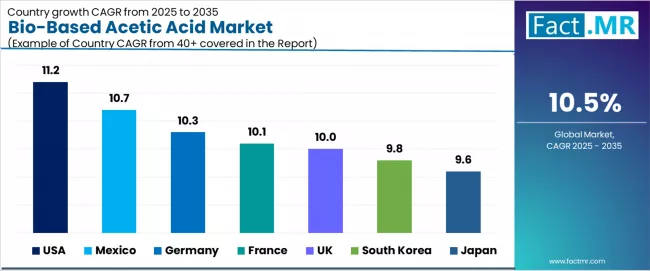
| Country | CAGR (2025-2035) |
|---|---|
| USA | 11.2% |
| Mexico | 10.7% |
| Germany | 10.3% |
| France | 10.1% |
| UK | 10.0% |
| South Korea | 9.8% |
| Japan | 9.6% |
The bio-based acetic acid market is experiencing exceptional growth globally, with the USA leading at an 11.2% CAGR through 2035, driven by expanding biotechnology sector and growing pharmaceutical manufacturing, alongside increasing adoption of sustainable chemical production technologies. Mexico follows at 10.7%, supported by agricultural waste availability, expanding chemical manufacturing, and growing demand for renewable chemicals in industrial applications.
Germany shows growth at 10.3%, emphasizing chemical industry innovation, sustainability leadership, and advanced biotechnology development. France demonstrates 10.1% growth, supported by biorefinery development and sustainable chemical initiatives. The UK records 10.0%, focusing on green chemistry innovation and sustainable manufacturing.
South Korea exhibits 9.8% growth, emphasizing biotechnology advancement and sustainable chemical production. Japan shows 9.6% growth, emphasizing precision fermentation and high-purity applications.
The report covers an in-depth analysis of 40+ countries; seven top-performing countries are highlighted below.
USA Leads Global Market Growth with Biotechnology and Pharmaceutical Expansion
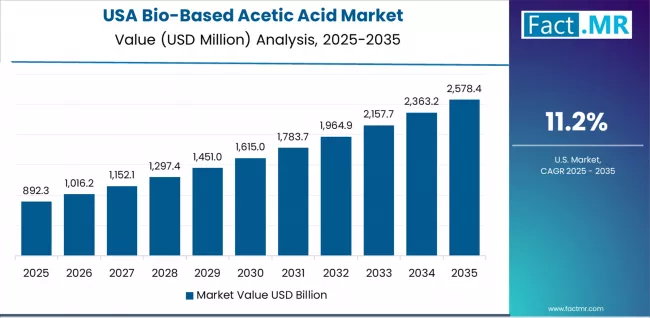
Revenue from bio-based acetic acid in the USA is projected to exhibit exceptional growth with a CAGR of 11.2% through 2035, driven by expanding biotechnology sector and rapidly growing pharmaceutical manufacturing supported by government sustainability initiatives and industrial modernization programs.
The country's substantial biotechnology infrastructure and increasing investment in sustainable chemical technologies are creating substantial demand for bio-based acetic acid solutions.
Major pharmaceutical manufacturers and chemical companies are establishing comprehensive bio-based production capabilities to serve both domestic markets and export opportunities.
- Government support for sustainable manufacturing and biotechnology development is driving demand for bio-based acetic acid throughout major industrial regions including California, Texas, and the Northeast biotechnology corridor, supporting both pharmaceutical applications and sustainable chemical production facilities.
- Strong pharmaceutical industry growth and expanding biotechnology sector are supporting the rapid adoption of bio-based acetic acid technologies among manufacturers seeking enhanced sustainability credentials and regulatory compliance in competitive global markets.
Mexico Demonstrates Strong Agricultural Integration with Feedstock Advantages
Revenue from bio-based acetic acid in Mexico is expanding at a CAGR of 10.7%, supported by abundant agricultural waste resources, growing chemical manufacturing sector, and strategic position as a renewable chemical production hub for North American markets.
Mexico's agricultural infrastructure and cost-competitive production environment are driving sophisticated bio-based chemical capabilities throughout industrial sectors. Leading chemical manufacturers and biotechnology companies are establishing extensive biorefinery facilities to address growing domestic and export demand.
- Abundant agricultural residues and expanding biorefinery infrastructure are creating opportunities for bio-based acetic acid production across waste valorization programs, sustainable chemical manufacturing, and renewable feedstock utilization in major agricultural regions including Central Mexico and agricultural corridors.
- Growing chemical industry and strategic trade relationships are supporting the adoption of advanced fermentation technologies among manufacturers seeking to serve both domestic and international markets while maintaining cost competitiveness and sustainability excellence.
Germany Demonstrates Chemical Industry Leadership with Innovation Excellence
Revenue from bio-based acetic acid in Germany is expanding at a CAGR of 10.3%, driven by the country's chemical industry leadership, advanced biotechnology capabilities, and precision engineering excellence supporting high-performance bio-based chemical applications.
Germany's chemical expertise and sustainability leadership are driving demand for specialized bio-based acetic acid solutions throughout technology sectors. Leading chemical manufacturers and biotechnology companies are establishing comprehensive innovation programs for next-generation sustainable chemical technologies.
- Advanced chemical engineering and sustainability requirements are creating demand for specialized bio-based acetic acid grades among chemical manufacturers and pharmaceutical companies seeking enhanced environmental performance and innovation differentiation in global markets.
- Strong chemical industry expertise and growing focus on circular economy are supporting the adoption of advanced fermentation technologies and bio-based chemical integration across manufacturing facilities throughout major industrial regions including North Rhine-Westphalia and Bavaria.
France Shows Biorefinery Innovation and Sustainability Leadership
Revenue from bio-based acetic acid in France is expanding at a CAGR of 10.1%, supported by the country's biorefinery development leadership, strong agricultural base, and pioneering sustainability initiatives including circular chemical production from agricultural waste materials. France's agricultural resources and environmental consciousness are supporting investment in advanced bio-based chemical technologies.
Major chemical manufacturers and agricultural companies are establishing comprehensive biorefinery programs incorporating renewable feedstock sourcing and sustainable chemical development.
- Advanced biorefinery capabilities and agricultural waste utilization are creating demand for innovative bio-based acetic acid production supporting sustainable chemical development and circular economy optimization throughout major agricultural and industrial regions.
- Strong sustainability focus and bioeconomy leadership are driving the adoption of waste-to-chemical production technologies and agricultural residue utilization throughout chemical manufacturing facilities across agricultural and industrial zones.
UK Focuses on Green Chemistry Innovation and Sustainable Manufacturing
Revenue from bio-based acetic acid in the UK is growing at a CAGR of 10.0%, driven by the country's green chemistry innovation, sustainable manufacturing initiatives, and emphasis on renewable chemical technologies for pharmaceutical and industrial applications.
The UK's research excellence and sustainability commitments are supporting investment in advanced bio-based chemical technologies. Major pharmaceutical manufacturers and chemical companies are establishing comprehensive sustainability programs incorporating bio-based chemical integration.
- Green chemistry research and sustainable manufacturing requirements are creating demand for high-performance bio-based acetic acid grades supporting pharmaceutical development, sustainable chemical production, and environmental compliance throughout major pharmaceutical and chemical clusters.
- Strong research capabilities and sustainability mandates are driving the adoption of advanced biotechnology processes and renewable chemical technologies supporting enhanced environmental performance and innovation leadership in competitive global markets.
South Korea Demonstrates Biotechnology Leadership with Advanced Applications
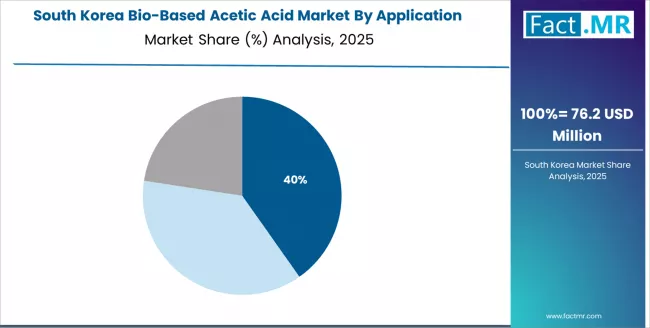
Revenue from bio-based acetic acid in South Korea is expanding at a CAGR of 9.8%, supported by the country's biotechnology advancement, chemical industry expertise, and strong emphasis on sustainable chemical production for advanced manufacturing applications.
South Korea's technological sophistication and innovation focus are driving sophisticated bio-based chemical capabilities throughout technology sectors. Leading chemical manufacturers and biotechnology companies are investing extensively in advanced fermentation technologies.
- Advanced biotechnology development and chemical manufacturing are creating demand for specialized bio-based acetic acid products throughout pharmaceutical applications, chemical production, and sustainable manufacturing facilities in major industrial regions including Seoul Capital Area and southeastern industrial zones.
- Strong technology industry and chemical expertise are supporting the adoption of innovative fermentation processes and biotechnology optimization technologies for next-generation applications requiring superior environmental performance and production efficiency.
Japan Shows Advanced Fermentation Focus with Precision Applications
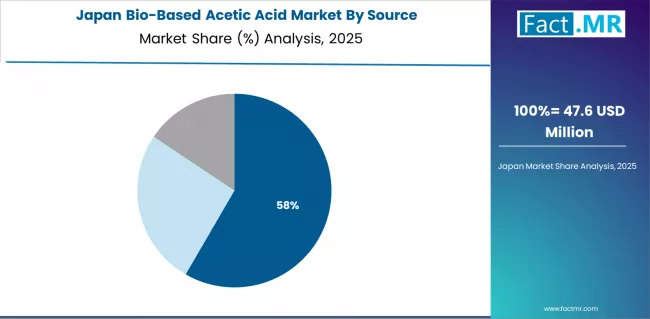
Revenue from bio-based acetic acid in Japan is expanding at a CAGR of 9.6%, supported by the country's leadership in precision fermentation, pharmaceutical manufacturing excellence, and strong emphasis on high-specification chemicals for advanced technology sectors.
Japan's technological sophistication and quality excellence are driving demand for premium bio-based acetic acid products. Leading pharmaceutical manufacturers and chemical companies are investing in specialized capabilities for advanced bio-based chemical applications.
- Advanced fermentation technology and precision manufacturing requirements are creating opportunities for high-purity bio-based acetic acid products throughout pharmaceutical production, specialty chemical manufacturing, and precision industrial applications meeting stringent quality and performance standards.
- Strong pharmaceutical industry and chemical sector are driving adoption of specialized bio-based acetic acid grades and advanced fermentation technologies supporting innovation in pharmaceutical, food processing, and specialty chemical sectors requiring superior material performance and consistency.
Europe Market Split by Country
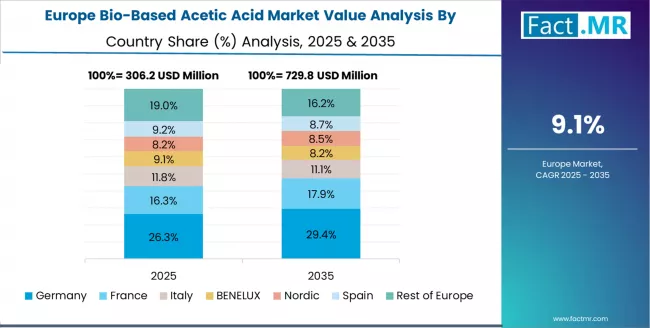
The bio-based acetic acid market in Europe is projected to grow from USD 420.0 million in 2025 to USD 1.14 billion by 2035, registering a CAGR of 10.5% over the forecast period. Germany is expected to maintain its leadership position with a 26.5% market share in 2025, declining slightly to 25.8% by 2035, supported by its advanced chemical industry and biotechnology innovation capabilities.
France follows with a 21.3% share in 2025, projected to reach 21.7% by 2035, driven by comprehensive biorefinery development and agricultural waste utilization programs. The United Kingdom holds a 18.2% share in 2025, expected to decrease to 17.9% by 2035 due to market diversification. Italy commands a 12.8% share, while Spain accounts for 9.4% in 2025.
The Rest of Europe region is anticipated to gain momentum, expanding its collective share from 11.8% to 12.3% by 2035, attributed to increasing bio-based chemical adoption in Nordic countries and emerging Eastern European biorefinery development implementing advanced fermentation technologies.
Competitive Landscape of the Bio-Based Acetic Acid Market
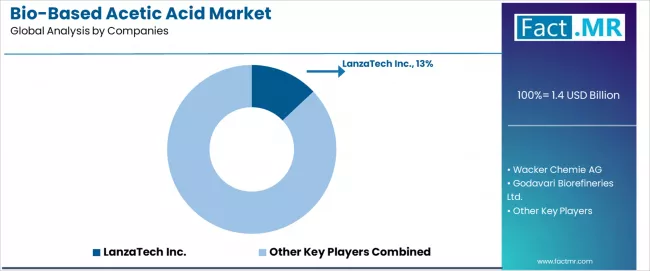
The bio-based acetic acid market is characterized by competition among established biotechnology companies, specialized chemical manufacturers, and diversified materials producers. Companies are investing in advanced fermentation technology development, sustainable production innovation, product portfolio expansion, and application-specific grade development to deliver high-performance, cost-effective, and environmentally responsible bio-based acetic acid solutions.
Innovation in synthetic biology approaches, feedstock optimization technologies, and advanced bioprocessing methods is central to strengthening market position and competitive advantage.
LanzaTech leads the market with a 13.0% share, offering comprehensive bio-based acetic acid solutions with a focus on waste-to-chemical technologies, advanced fermentation processes, and sustainable production across diverse industrial and consumer applications. The company has announced major capacity expansion initiatives and investments in synthetic biology technologies to support growing global demand for renewable chemicals and circular economy applications.
Wacker Chemie provides innovative chemical solutions with emphasis on biotechnology integration and quality excellence, while Godavari Biorefineries delivers bio-based chemicals with focus on agricultural waste utilization and sustainable production. Afyren offers advanced fermentation solutions with comprehensive bio-based chemical offerings for industrial applications, and Zea2 provides innovative biotechnology with emphasis on performance optimization and sustainability.
Novozymes specializes in enzyme technologies supporting bio-based chemical production, while Carbon Recycling International focuses on waste-to-chemical processes. Other key players including BP Bioacids, BioChemtex, and Sekab contribute to market competition through specialized production capabilities and regional market presence.
Bio-Based Acetic Acid Market - Stakeholder Contribution Framework
Bio-based acetic acid represents a sustainable chemical segment within industrial and consumer applications, projected to grow from USD 1.4 billion in 2025 to USD 3.8 billion by 2035 at a 10.5% CAGR.
These renewable chemical products—primarily fermentation-based and synthetic biology configurations for multiple applications—serve as critical sustainable materials in food processing, pharmaceutical manufacturing, chemical production, and industrial applications where environmental performance, regulatory compliance, and carbon footprint reduction are essential.
Market expansion is driven by increasing sustainability regulations, growing circular economy adoption, expanding biotechnology capabilities, and rising demand for renewable chemical solutions across diverse food processing, pharmaceutical, chemical manufacturing, and industrial sectors.
How Environmental Regulators Could Strengthen Sustainability Standards and Carbon Reduction?
- Renewable Chemical Standards: Establish comprehensive technical specifications for bio-based acetic acid products, including carbon footprint requirements, renewable content verification, sustainability certification, and environmental performance standards that ensure consistent quality across food processing, pharmaceutical, chemical, and industrial applications.
- Circular Economy Integration: Develop regulatory frameworks that incentivize waste-to-chemical production, requiring manufacturers to utilize agricultural residues, implement circular feedstock sourcing, incorporate waste valorization technologies, and achieve measurable carbon footprint reductions in bio-based chemical production processes.
- Sustainability Certification Requirements: Implement mandatory sustainability verification standards for bio-based acetic acid manufacturing, including lifecycle assessment protocols, carbon footprint measurement, and traceability systems that ensure environmental performance and application reliability across diverse end-use sectors.
- Pharmaceutical Grade Guidelines: Create specialized regulations for pharmaceutical-grade bio-based acetic acid used in drug manufacturing, addressing stringent purity specifications, sustainability requirements, and safety validation specific to pharmaceutical applications requiring enhanced reliability and environmental credentials.
- Innovation Incentive Programs: Provide regulatory facilitation and financial incentives for research and development of next-generation bio-based chemical technologies that improve environmental performance, reduce production costs, and enable emerging applications in sustainable manufacturing and circular economy initiatives.
How Industry Associations Could Advance Biotechnology Standards and Market Development?
- Production Best Practices: Develop comprehensive technical guidelines for bio-based acetic acid production, fermentation optimization, and quality control techniques that maximize environmental benefits, ensure product quality, and maintain cost-effectiveness across biotechnology, chemical manufacturing, and industrial applications.
- Sustainability Benchmarking: Establish industry-wide metrics for environmental performance, including carbon footprint intensity, renewable content verification, waste reduction achievements, and circular economy integration that enable comparative analysis and drive continuous improvement toward sustainability objectives.
- Biotechnology Training Programs: Create specialized education initiatives for bioprocess engineers, fermentation specialists, and production personnel covering bio-based chemical characteristics, fermentation requirements, sustainability optimization, and quality assurance techniques across diverse biotechnology applications.
- Environmental Performance Standardization: Develop standardized testing methodologies for bio-based acetic acid environmental evaluation, including carbon footprint assessment, renewable content verification, sustainability impact analysis, and application-specific environmental metrics that facilitate objective product comparison.
- Cross-Industry Collaboration: Facilitate partnerships between bio-based chemical manufacturers, end-user industries, research institutions, and biotechnology suppliers to advance sustainable technology development, address emerging sustainability challenges, and accelerate innovation in renewable chemical materials.
How Bio-Based Chemical Manufacturers Could Drive Innovation and Sustainability Leadership?
- Advanced Fermentation Technologies: Invest in synthetic biology integration, engineered microorganism development, continuous fermentation processes, and bioprocess optimization improvements that enhance production efficiency while maintaining product quality and cost competitiveness in global markets.
- Sustainable Feedstock Development: Develop next-generation bio-based production methods with optimized agricultural waste utilization, including waste-to-chemical processes, circular feedstock sourcing, enhanced conversion efficiency, and feedstock-specific optimization attributes for emerging sustainability segments.
- Digital Bioprocessing Integration: Implement intelligent fermentation systems with real-time bioprocess monitoring, predictive maintenance capabilities, automated quality control, and data analytics that optimize production efficiency, ensure consistent product quality, and reduce manufacturing costs.
- Application Technical Support: Establish comprehensive customer service capabilities providing formulation assistance, sustainability consulting, environmental impact assessment, and technical expertise that strengthen customer relationships and enable successful sustainable chemical implementation.
- Global Biorefinery Excellence: Develop regional biorefinery facilities, sustainable supply chain management, reliable feedstock networks, and responsive customer service that ensure consistent product availability, minimize carbon footprint, and support customer sustainability requirements worldwide.
How End-User Industries Could Optimize Sustainability Performance and Cost-Effectiveness?
- Strategic Sustainable Sourcing: Conduct comprehensive assessments of environmental requirements, cost constraints, sustainability objectives, and quality specifications to optimize bio-based acetic acid selection and achieve desired environmental characteristics while managing total system costs.
- Process Integration Optimization: Implement advanced development methodologies utilizing sustainability assessment, process optimization, and systematic environmental evaluation to maximize bio-based chemical benefits, minimize environmental impact, and optimize overall production sustainability.
- Sustainability Management: Develop optimized sourcing protocols, environmental impact procedures, and sustainability validation that ensure effective bio-based chemical integration, maximize environmental benefits, and maintain consistent sustainability performance throughout production operations.
- Circular Economy Integration: Incorporate lifecycle assessment methodologies, circular economy principles, and carbon footprint considerations into material selection and product development processes that support comprehensive sustainability objectives and stakeholder expectations.
- Collaborative Sustainability: Establish strategic partnerships with bio-based chemical suppliers for joint sustainability programs, environmental impact initiatives, and co-innovation projects that address specific sustainability challenges and accelerate sustainable product commercialization.
How Research Institutions Could Enable Biotechnology Advancement?
- Fundamental Biotechnology Research: Conduct scientific investigations into fermentation mechanisms, synthetic biology applications, bioprocess optimization, and sustainable production development that advance fundamental understanding and enable breakthrough innovations in renewable chemical production.
- Bioprocess Technology Development: Develop novel fermentation methods, including advanced synthetic biology approaches, waste-to-chemical processes, and circular biorefinery technologies that improve sustainability performance while maintaining product quality and economic viability.
- Application Innovation: Investigate emerging applications for bio-based acetic acid in advanced pharmaceutical formulations, sustainable food processing, renewable chemical intermediates, and high-performance industrial materials that create new market opportunities and expand sustainability potential.
- Biotechnology Capabilities: Provide advanced bioprocess characterization services utilizing fermentation analysis, metabolic assessment, sustainability evaluation, and environmental impact methodologies that enable detailed understanding of bio-based chemical properties and production behavior.
- Industry Knowledge Transfer: Facilitate biotechnology commercialization through licensing agreements, startup incubation programs, technical publications, and collaborative research projects that accelerate sustainable innovation adoption and strengthen industry-academia partnerships.
How Investors and Financial Enablers Could Support Sustainable Market Growth?
- Biorefinery Infrastructure Investment: Provide capital for bio-based chemical manufacturing facility construction, fermentation capacity expansion, and biotechnology upgrade projects that address growing sustainability demand while improving operational efficiency and environmental performance.
- Innovation Financing: Fund research and development of breakthrough bio-based chemical technologies, including advanced synthetic biology methods, waste-to-chemical processes, and novel sustainability applications that address current market limitations and create competitive advantages.
- Sustainability Project Support: Finance circular economy initiatives, renewable feedstock development, waste valorization programs, and carbon reduction initiatives that enhance environmental credentials and position manufacturers for long-term regulatory compliance and market acceptance.
- Market Expansion Enablement: Support strategic acquisitions, sustainability market entry initiatives, biorefinery network development, and customer sustainability service capabilities that accelerate geographic expansion and strengthen competitive positions in high-growth sustainable markets.
- Emerging Bioeconomy Development: Provide financing and technical assistance for bio-based chemical production facilities in developing economies, creating new sustainable supply capabilities, supporting local bioeconomy development, and expanding global market access for renewable chemical solutions.
Key Players in the Bio-Based Acetic Acid Market
- LanzaTech Inc.
- Wacker Chemie AG
- Godavari Biorefineries Ltd.
- Afyren S.A.
- Zea2
- Novozymes A/S
- Carbon Recycling International (CRI)
- BP Bioacids (BP plc)
- BioChemtex S.r.l.
- Sekab E-Technology AB
Scope of the Report
| Items | Values |
|---|---|
| Quantitative Units (2025) | USD 1.4 Billion |
| Source | Biomass Fermentation, Synthetic Biology, Others |
| Application | Food & Beverage, Chemicals, Others |
| End Use | Industrial, Consumer |
| Regions Covered | North America, Europe, East Asia, South Asia, Latin America, Middle East & Africa, Eastern Europe |
| Countries Covered | USA, Germany, France, UK, Japan, South Korea, Mexico, and 40+ countries |
| Key Companies Profiled | LanzaTech, Wacker Chemie, Godavari Biorefineries, Afyren, Zea2, Novozymes |
| Additional Attributes | Dollar sales by source and application category, regional demand trends, competitive landscape, technological advancements in biotechnology production, sustainability development, circular economy innovation, and environmental performance optimization |
Bio-Based Acetic Acid Market by Segments
-
Source :
- Biomass Fermentation
- Synthetic Biology
- Others
-
Application :
- Food & Beverage
- Chemicals
- Others
-
End Use :
- Industrial
- Consumer
-
Region :
-
East Asia
- China
- Japan
- South Korea
- Taiwan
- Rest of East Asia
-
Europe
- Germany
- United Kingdom
- France
- Italy
- Spain
- Netherlands
- Nordic
- BENELUX
- Rest of Europe
-
North America
- United States
- Canada
- Mexico
-
South Asia
- India
- Pakistan
- Bangladesh
- Rest of South Asia
-
Latin America
- Brazil
- Argentina
- Chile
- Rest of Latin America
-
Middle East & Africa
- Kingdom of Saudi Arabia
- Other GCC Countries
- Turkey
- South Africa
- Other African Union
- Rest of Middle East & Africa
-
Eastern Europe
- Russia
- Poland
- Czech Republic
- Rest of Eastern Europe
-
Table of Content
- Executive Summary
- Global Market Outlook
- Demand to side Trends
- Supply to side Trends
- Technology Roadmap Analysis
- Analysis and Recommendations
- Market Overview
- Market Coverage / Taxonomy
- Market Definition / Scope / Limitations
- Market Background
- Market Dynamics
- Drivers
- Restraints
- Opportunity
- Trends
- Scenario Forecast
- Demand in Optimistic Scenario
- Demand in Likely Scenario
- Demand in Conservative Scenario
- Opportunity Map Analysis
- Product Life Cycle Analysis
- Supply Chain Analysis
- Investment Feasibility Matrix
- Value Chain Analysis
- PESTLE and Porter’s Analysis
- Regulatory Landscape
- Regional Parent Market Outlook
- Production and Consumption Statistics
- Import and Export Statistics
- Market Dynamics
- Global Market Analysis 2020 to 2024 and Forecast, 2025 to 2035
- Historical Market Size Value (USD Million) Analysis, 2020 to 2024
- Current and Future Market Size Value (USD Million) Projections, 2025 to 2035
- Y to o to Y Growth Trend Analysis
- Absolute $ Opportunity Analysis
- Global Market Pricing Analysis 2020 to 2024 and Forecast 2025 to 2035
- Global Market Analysis 2020 to 2024 and Forecast 2025 to 2035, By Source
- Introduction / Key Findings
- Historical Market Size Value (USD Million) Analysis By Source , 2020 to 2024
- Current and Future Market Size Value (USD Million) Analysis and Forecast By Source , 2025 to 2035
- Biomass Fermentation
- Synthetic Biology
- Others
- Y to o to Y Growth Trend Analysis By Source , 2020 to 2024
- Absolute $ Opportunity Analysis By Source , 2025 to 2035
- Global Market Analysis 2020 to 2024 and Forecast 2025 to 2035, By Application
- Introduction / Key Findings
- Historical Market Size Value (USD Million) Analysis By Application, 2020 to 2024
- Current and Future Market Size Value (USD Million) Analysis and Forecast By Application, 2025 to 2035
- Food & Beverage
- Chemicals
- Others
- Y to o to Y Growth Trend Analysis By Application, 2020 to 2024
- Absolute $ Opportunity Analysis By Application, 2025 to 2035
- Global Market Analysis 2020 to 2024 and Forecast 2025 to 2035, By End Use
- Introduction / Key Findings
- Historical Market Size Value (USD Million) Analysis By End Use, 2020 to 2024
- Current and Future Market Size Value (USD Million) Analysis and Forecast By End Use, 2025 to 2035
- Industrial
- Consumer
- Y to o to Y Growth Trend Analysis By End Use, 2020 to 2024
- Absolute $ Opportunity Analysis By End Use, 2025 to 2035
- Global Market Analysis 2020 to 2024 and Forecast 2025 to 2035, By Region
- Introduction
- Historical Market Size Value (USD Million) Analysis By Region, 2020 to 2024
- Current Market Size Value (USD Million) Analysis and Forecast By Region, 2025 to 2035
- North America
- Latin America
- Western Europe
- Eastern Europe
- East Asia
- South Asia and Pacific
- Middle East & Africa
- Market Attractiveness Analysis By Region
- North America Market Analysis 2020 to 2024 and Forecast 2025 to 2035, By Country
- Historical Market Size Value (USD Million) Trend Analysis By Market Taxonomy, 2020 to 2024
- Market Size Value (USD Million) Forecast By Market Taxonomy, 2025 to 2035
- By Country
- USA
- Canada
- Mexico
- By Source
- By Application
- By End Use
- By Country
- Market Attractiveness Analysis
- By Country
- By Source
- By Application
- By End Use
- Key Takeaways
- Latin America Market Analysis 2020 to 2024 and Forecast 2025 to 2035, By Country
- Historical Market Size Value (USD Million) Trend Analysis By Market Taxonomy, 2020 to 2024
- Market Size Value (USD Million) Forecast By Market Taxonomy, 2025 to 2035
- By Country
- Brazil
- Chile
- Rest of Latin America
- By Source
- By Application
- By End Use
- By Country
- Market Attractiveness Analysis
- By Country
- By Source
- By Application
- By End Use
- Key Takeaways
- Western Europe Market Analysis 2020 to 2024 and Forecast 2025 to 2035, By Country
- Historical Market Size Value (USD Million) Trend Analysis By Market Taxonomy, 2020 to 2024
- Market Size Value (USD Million) Forecast By Market Taxonomy, 2025 to 2035
- By Country
- Germany
- UK
- Italy
- Spain
- France
- Nordic
- BENELUX
- Rest of Western Europe
- By Source
- By Application
- By End Use
- By Country
- Market Attractiveness Analysis
- By Country
- By Source
- By Application
- By End Use
- Key Takeaways
- Eastern Europe Market Analysis 2020 to 2024 and Forecast 2025 to 2035, By Country
- Historical Market Size Value (USD Million) Trend Analysis By Market Taxonomy, 2020 to 2024
- Market Size Value (USD Million) Forecast By Market Taxonomy, 2025 to 2035
- By Country
- Russia
- Poland
- Hungary
- Balkan & Baltic
- Rest of Eastern Europe
- By Source
- By Application
- By End Use
- By Country
- Market Attractiveness Analysis
- By Country
- By Source
- By Application
- By End Use
- Key Takeaways
- East Asia Market Analysis 2020 to 2024 and Forecast 2025 to 2035, By Country
- Historical Market Size Value (USD Million) Trend Analysis By Market Taxonomy, 2020 to 2024
- Market Size Value (USD Million) Forecast By Market Taxonomy, 2025 to 2035
- By Country
- China
- Japan
- South Korea
- By Source
- By Application
- By End Use
- By Country
- Market Attractiveness Analysis
- By Country
- By Source
- By Application
- By End Use
- Key Takeaways
- South Asia and Pacific Market Analysis 2020 to 2024 and Forecast 2025 to 2035, By Country
- Historical Market Size Value (USD Million) Trend Analysis By Market Taxonomy, 2020 to 2024
- Market Size Value (USD Million) Forecast By Market Taxonomy, 2025 to 2035
- By Country
- India
- ASEAN
- Australia & New Zealand
- Rest of South Asia and Pacific
- By Source
- By Application
- By End Use
- By Country
- Market Attractiveness Analysis
- By Country
- By Source
- By Application
- By End Use
- Key Takeaways
- Middle East & Africa Market Analysis 2020 to 2024 and Forecast 2025 to 2035, By Country
- Historical Market Size Value (USD Million) Trend Analysis By Market Taxonomy, 2020 to 2024
- Market Size Value (USD Million) Forecast By Market Taxonomy, 2025 to 2035
- By Country
- Kingdom of Saudi Arabia
- Other GCC Countries
- Turkiye
- South Africa
- Other African Union
- Rest of Middle East & Africa
- By Source
- By Application
- By End Use
- By Country
- Market Attractiveness Analysis
- By Country
- By Source
- By Application
- By End Use
- Key Takeaways
- Key Countries Market Analysis
- USA
- Pricing Analysis
- Market Share Analysis, 2024
- By Source
- By Application
- By End Use
- Canada
- Pricing Analysis
- Market Share Analysis, 2024
- By Source
- By Application
- By End Use
- Mexico
- Pricing Analysis
- Market Share Analysis, 2024
- By Source
- By Application
- By End Use
- Brazil
- Pricing Analysis
- Market Share Analysis, 2024
- By Source
- By Application
- By End Use
- Chile
- Pricing Analysis
- Market Share Analysis, 2024
- By Source
- By Application
- By End Use
- Germany
- Pricing Analysis
- Market Share Analysis, 2024
- By Source
- By Application
- By End Use
- UK
- Pricing Analysis
- Market Share Analysis, 2024
- By Source
- By Application
- By End Use
- Italy
- Pricing Analysis
- Market Share Analysis, 2024
- By Source
- By Application
- By End Use
- Spain
- Pricing Analysis
- Market Share Analysis, 2024
- By Source
- By Application
- By End Use
- France
- Pricing Analysis
- Market Share Analysis, 2024
- By Source
- By Application
- By End Use
- India
- Pricing Analysis
- Market Share Analysis, 2024
- By Source
- By Application
- By End Use
- ASEAN
- Pricing Analysis
- Market Share Analysis, 2024
- By Source
- By Application
- By End Use
- Australia & New Zealand
- Pricing Analysis
- Market Share Analysis, 2024
- By Source
- By Application
- By End Use
- China
- Pricing Analysis
- Market Share Analysis, 2024
- By Source
- By Application
- By End Use
- Japan
- Pricing Analysis
- Market Share Analysis, 2024
- By Source
- By Application
- By End Use
- South Korea
- Pricing Analysis
- Market Share Analysis, 2024
- By Source
- By Application
- By End Use
- Russia
- Pricing Analysis
- Market Share Analysis, 2024
- By Source
- By Application
- By End Use
- Poland
- Pricing Analysis
- Market Share Analysis, 2024
- By Source
- By Application
- By End Use
- Hungary
- Pricing Analysis
- Market Share Analysis, 2024
- By Source
- By Application
- By End Use
- Kingdom of Saudi Arabia
- Pricing Analysis
- Market Share Analysis, 2024
- By Source
- By Application
- By End Use
- Turkiye
- Pricing Analysis
- Market Share Analysis, 2024
- By Source
- By Application
- By End Use
- South Africa
- Pricing Analysis
- Market Share Analysis, 2024
- By Source
- By Application
- By End Use
- USA
- Market Structure Analysis
- Competition Dashboard
- Competition Benchmarking
- Market Share Analysis of Top Players
- By Regional
- By Source
- By Application
- By End Use
- Competition Analysis
- Competition Deep Dive
- LanzaTech Inc.
- Overview
- Product Portfolio
- Profitability by Market Segments (Product/Age /Sales Channel/Region)
- Sales Footprint
- Strategy Overview
- Marketing Strategy
- Product Strategy
- Channel Strategy
- Wacker Chemie AG
- Godavari Biorefineries Ltd.
- Afyren S.A.
- Zea2
- Novozymes A/S
- Carbon Recycling International (CRI)
- BP Bioacids (BP plc)
- BioChemtex S.r.l.
- Sekab E-Technology AB
- LanzaTech Inc.
- Competition Deep Dive
- Assumptions & Acronyms Used
- Research Methodology
List Of Table
- Table 1: Global Market Value (USD Million) Forecast by Region, 2020 to 2035
- Table 2: Global Market Value (USD Million) Forecast by Source , 2020 to 2035
- Table 3: Global Market Value (USD Million) Forecast by Application, 2020 to 2035
- Table 4: Global Market Value (USD Million) Forecast by End Use, 2020 to 2035
- Table 5: North America Market Value (USD Million) Forecast by Country, 2020 to 2035
- Table 6: North America Market Value (USD Million) Forecast by Source , 2020 to 2035
- Table 7: North America Market Value (USD Million) Forecast by Application, 2020 to 2035
- Table 8: North America Market Value (USD Million) Forecast by End Use, 2020 to 2035
- Table 9: Latin America Market Value (USD Million) Forecast by Country, 2020 to 2035
- Table 10: Latin America Market Value (USD Million) Forecast by Source , 2020 to 2035
- Table 11: Latin America Market Value (USD Million) Forecast by Application, 2020 to 2035
- Table 12: Latin America Market Value (USD Million) Forecast by End Use, 2020 to 2035
- Table 13: Western Europe Market Value (USD Million) Forecast by Country, 2020 to 2035
- Table 14: Western Europe Market Value (USD Million) Forecast by Source , 2020 to 2035
- Table 15: Western Europe Market Value (USD Million) Forecast by Application, 2020 to 2035
- Table 16: Western Europe Market Value (USD Million) Forecast by End Use, 2020 to 2035
- Table 17: Eastern Europe Market Value (USD Million) Forecast by Country, 2020 to 2035
- Table 18: Eastern Europe Market Value (USD Million) Forecast by Source , 2020 to 2035
- Table 19: Eastern Europe Market Value (USD Million) Forecast by Application, 2020 to 2035
- Table 20: Eastern Europe Market Value (USD Million) Forecast by End Use, 2020 to 2035
- Table 21: East Asia Market Value (USD Million) Forecast by Country, 2020 to 2035
- Table 22: East Asia Market Value (USD Million) Forecast by Source , 2020 to 2035
- Table 23: East Asia Market Value (USD Million) Forecast by Application, 2020 to 2035
- Table 24: East Asia Market Value (USD Million) Forecast by End Use, 2020 to 2035
- Table 25: South Asia and Pacific Market Value (USD Million) Forecast by Country, 2020 to 2035
- Table 26: South Asia and Pacific Market Value (USD Million) Forecast by Source , 2020 to 2035
- Table 27: South Asia and Pacific Market Value (USD Million) Forecast by Application, 2020 to 2035
- Table 28: South Asia and Pacific Market Value (USD Million) Forecast by End Use, 2020 to 2035
- Table 29: Middle East & Africa Market Value (USD Million) Forecast by Country, 2020 to 2035
- Table 30: Middle East & Africa Market Value (USD Million) Forecast by Source , 2020 to 2035
- Table 31: Middle East & Africa Market Value (USD Million) Forecast by Application, 2020 to 2035
- Table 32: Middle East & Africa Market Value (USD Million) Forecast by End Use, 2020 to 2035
List Of Figures
- Figure 1: Global Market Pricing Analysis
- Figure 2: Global Market Value (USD Million) Forecast 2020-2035
- Figure 3: Global Market Value Share and BPS Analysis by Source , 2025 and 2035
- Figure 4: Global Market Y to o to Y Growth Comparison by Source , 2025-2035
- Figure 5: Global Market Attractiveness Analysis by Source
- Figure 6: Global Market Value Share and BPS Analysis by Application, 2025 and 2035
- Figure 7: Global Market Y to o to Y Growth Comparison by Application, 2025-2035
- Figure 8: Global Market Attractiveness Analysis by Application
- Figure 9: Global Market Value Share and BPS Analysis by End Use, 2025 and 2035
- Figure 10: Global Market Y to o to Y Growth Comparison by End Use, 2025-2035
- Figure 11: Global Market Attractiveness Analysis by End Use
- Figure 12: Global Market Value (USD Million) Share and BPS Analysis by Region, 2025 and 2035
- Figure 13: Global Market Y to o to Y Growth Comparison by Region, 2025-2035
- Figure 14: Global Market Attractiveness Analysis by Region
- Figure 15: North America Market Incremental Dollar Opportunity, 2025-2035
- Figure 16: Latin America Market Incremental Dollar Opportunity, 2025-2035
- Figure 17: Western Europe Market Incremental Dollar Opportunity, 2025-2035
- Figure 18: Eastern Europe Market Incremental Dollar Opportunity, 2025-2035
- Figure 19: East Asia Market Incremental Dollar Opportunity, 2025-2035
- Figure 20: South Asia and Pacific Market Incremental Dollar Opportunity, 2025-2035
- Figure 21: Middle East & Africa Market Incremental Dollar Opportunity, 2025-2035
- Figure 22: North America Market Value Share and BPS Analysis by Country, 2025 and 2035
- Figure 23: North America Market Value Share and BPS Analysis by Source , 2025 and 2035
- Figure 24: North America Market Y to o to Y Growth Comparison by Source , 2025-2035
- Figure 25: North America Market Attractiveness Analysis by Source
- Figure 26: North America Market Value Share and BPS Analysis by Application, 2025 and 2035
- Figure 27: North America Market Y to o to Y Growth Comparison by Application, 2025-2035
- Figure 28: North America Market Attractiveness Analysis by Application
- Figure 29: North America Market Value Share and BPS Analysis by End Use, 2025 and 2035
- Figure 30: North America Market Y to o to Y Growth Comparison by End Use, 2025-2035
- Figure 31: North America Market Attractiveness Analysis by End Use
- Figure 32: Latin America Market Value Share and BPS Analysis by Country, 2025 and 2035
- Figure 33: Latin America Market Value Share and BPS Analysis by Source , 2025 and 2035
- Figure 34: Latin America Market Y to o to Y Growth Comparison by Source , 2025-2035
- Figure 35: Latin America Market Attractiveness Analysis by Source
- Figure 36: Latin America Market Value Share and BPS Analysis by Application, 2025 and 2035
- Figure 37: Latin America Market Y to o to Y Growth Comparison by Application, 2025-2035
- Figure 38: Latin America Market Attractiveness Analysis by Application
- Figure 39: Latin America Market Value Share and BPS Analysis by End Use, 2025 and 2035
- Figure 40: Latin America Market Y to o to Y Growth Comparison by End Use, 2025-2035
- Figure 41: Latin America Market Attractiveness Analysis by End Use
- Figure 42: Western Europe Market Value Share and BPS Analysis by Country, 2025 and 2035
- Figure 43: Western Europe Market Value Share and BPS Analysis by Source , 2025 and 2035
- Figure 44: Western Europe Market Y to o to Y Growth Comparison by Source , 2025-2035
- Figure 45: Western Europe Market Attractiveness Analysis by Source
- Figure 46: Western Europe Market Value Share and BPS Analysis by Application, 2025 and 2035
- Figure 47: Western Europe Market Y to o to Y Growth Comparison by Application, 2025-2035
- Figure 48: Western Europe Market Attractiveness Analysis by Application
- Figure 49: Western Europe Market Value Share and BPS Analysis by End Use, 2025 and 2035
- Figure 50: Western Europe Market Y to o to Y Growth Comparison by End Use, 2025-2035
- Figure 51: Western Europe Market Attractiveness Analysis by End Use
- Figure 52: Eastern Europe Market Value Share and BPS Analysis by Country, 2025 and 2035
- Figure 53: Eastern Europe Market Value Share and BPS Analysis by Source , 2025 and 2035
- Figure 54: Eastern Europe Market Y to o to Y Growth Comparison by Source , 2025-2035
- Figure 55: Eastern Europe Market Attractiveness Analysis by Source
- Figure 56: Eastern Europe Market Value Share and BPS Analysis by Application, 2025 and 2035
- Figure 57: Eastern Europe Market Y to o to Y Growth Comparison by Application, 2025-2035
- Figure 58: Eastern Europe Market Attractiveness Analysis by Application
- Figure 59: Eastern Europe Market Value Share and BPS Analysis by End Use, 2025 and 2035
- Figure 60: Eastern Europe Market Y to o to Y Growth Comparison by End Use, 2025-2035
- Figure 61: Eastern Europe Market Attractiveness Analysis by End Use
- Figure 62: East Asia Market Value Share and BPS Analysis by Country, 2025 and 2035
- Figure 63: East Asia Market Value Share and BPS Analysis by Source , 2025 and 2035
- Figure 64: East Asia Market Y to o to Y Growth Comparison by Source , 2025-2035
- Figure 65: East Asia Market Attractiveness Analysis by Source
- Figure 66: East Asia Market Value Share and BPS Analysis by Application, 2025 and 2035
- Figure 67: East Asia Market Y to o to Y Growth Comparison by Application, 2025-2035
- Figure 68: East Asia Market Attractiveness Analysis by Application
- Figure 69: East Asia Market Value Share and BPS Analysis by End Use, 2025 and 2035
- Figure 70: East Asia Market Y to o to Y Growth Comparison by End Use, 2025-2035
- Figure 71: East Asia Market Attractiveness Analysis by End Use
- Figure 72: South Asia and Pacific Market Value Share and BPS Analysis by Country, 2025 and 2035
- Figure 73: South Asia and Pacific Market Value Share and BPS Analysis by Source , 2025 and 2035
- Figure 74: South Asia and Pacific Market Y to o to Y Growth Comparison by Source , 2025-2035
- Figure 75: South Asia and Pacific Market Attractiveness Analysis by Source
- Figure 76: South Asia and Pacific Market Value Share and BPS Analysis by Application, 2025 and 2035
- Figure 77: South Asia and Pacific Market Y to o to Y Growth Comparison by Application, 2025-2035
- Figure 78: South Asia and Pacific Market Attractiveness Analysis by Application
- Figure 79: South Asia and Pacific Market Value Share and BPS Analysis by End Use, 2025 and 2035
- Figure 80: South Asia and Pacific Market Y to o to Y Growth Comparison by End Use, 2025-2035
- Figure 81: South Asia and Pacific Market Attractiveness Analysis by End Use
- Figure 82: Middle East & Africa Market Value Share and BPS Analysis by Country, 2025 and 2035
- Figure 83: Middle East & Africa Market Value Share and BPS Analysis by Source , 2025 and 2035
- Figure 84: Middle East & Africa Market Y to o to Y Growth Comparison by Source , 2025-2035
- Figure 85: Middle East & Africa Market Attractiveness Analysis by Source
- Figure 86: Middle East & Africa Market Value Share and BPS Analysis by Application, 2025 and 2035
- Figure 87: Middle East & Africa Market Y to o to Y Growth Comparison by Application, 2025-2035
- Figure 88: Middle East & Africa Market Attractiveness Analysis by Application
- Figure 89: Middle East & Africa Market Value Share and BPS Analysis by End Use, 2025 and 2035
- Figure 90: Middle East & Africa Market Y to o to Y Growth Comparison by End Use, 2025-2035
- Figure 91: Middle East & Africa Market Attractiveness Analysis by End Use
- Figure 92: Global Market - Tier Structure Analysis
- Figure 93: Global Market - Company Share Analysis
- FAQs -
How big is the bio-based acetic acid market in 2025?
The global bio-based acetic acid market is estimated to be valued at USD 1.4 billion in 2025.
What will be the size of bio-based acetic acid market in 2035?
The market size for the bio-based acetic acid market is projected to reach USD 3.8 billion by 2035.
How much will be the bio-based acetic acid market growth between 2025 and 2035?
The bio-based acetic acid market is expected to grow at a 10.5% CAGR between 2025 and 2035.
What are the key product types in the bio-based acetic acid market?
The key product types in bio-based acetic acid market are biomass fermentation, synthetic biology and others.
Which application segment to contribute significant share in the bio-based acetic acid market in 2025?
In terms of application, food & beverage segment to command 42.0% share in the bio-based acetic acid market in 2025.